Do you find it challenging to select chords that fit well with a melody or song? You're not alone in facing this hurdle, so there's no need to be concerned.
I will guide you on a simple approach to discovering the chords for a song and illustrate how to identify the correct ones through a straightforward, step-by-step process.
To commence this lesson, I will play a well-known melody that you can readily identify. The song I've chosen is none other than the ubiquitous Happy Birthday tune that is familiar to virtually everyone.
I intentionally selected an uncomplicated piece to assist you in honing your ability to discover chords. So, without further ado, let's delve into it!
Step #1 Find the Key

The first step is to find out what key the melody is in. Go up and down your guitar by a half fret until you find the note that feels like "home".
Then once you figure out the home note, go up and down playing a scale starting on that note. For this song example, home is the key of C so we will go over the C scale.
Now at this time, you would want to determine if the home key is major or minor. Normally I would play both the major scale and the minor scale to see which one works better.
This initial process helps you choose the chords for the melody based on the most important step of defining the songs key.
If this is completely new to you or you still feel like you are struggling with finding the key to a song, click on the link below to get more help with that!
Step #2 Write out the chords in the key
The Happy Birthday song can be played in any key you'd like. For this example, we are going to play it in the key of C. The notes for the key of C are shown below.

We will create the chords using each note in the scale plus 2 other notes. Skip every other following note after the first one to form the chords.
For example, in the first chord, the C chord is C-E-G - so to create this chord you skip the D and the F notes. To further illustrate this, the D minor chord is made up of D - F - A. Here you would skip the E and the G notes.
For the next step, it really helps if you write out the chords for the key you are in, and it would also be beneficial for you to write out all the notes that are in each of the chords.
Step #3 Match the Melody Notes with the Chord

Next, we are going to look at the melody notes in the song and play chords that mostly have the same notes in the chords as the melody or contain notes that create some tension that resolves to the chord.
Here are the first notes in the first phrase of the song Happy Birthday - G-G-A-G-C-B. The first 2 notes, the 2 G's, are what's called a "pickup" that leads us into the 1st measure of the song.
The strum beat is on the A note and this note is full of tension that resolves itself on the next note, the G note. The B note at the end of this musical phrase, basically leads us into the next measure.
To get started with our first chord, we look for a chord that has the G note in them that best matches with the melody. That would be the C chord!
At the end of the phrase, the B note matches with the G chord. So, we start the phrase using the C chord and then end the phrase on a G chord.


A lot of times in a song, the beginning of the song starts with the chord which is also the name of the key of the song.
So if you try it out, you will see that if you play the C chord while singing the melody, this chord is the best one to start the song with.
This C chord matches the sound and also helps establish the key of the song. In the beginning, try to come up with one chord per melodic phrase.
Give priority to the I, IV, and V chords in the key. Why? Because those three chords are the skeleton for the rest of the chords which will help further establish the key.
Playing the melody with the chords, you can see how the chords match up better or worse with the notes of the melody. Your ear will tell you what is right and what is wrong, so trust it!
The next melodic phrase, G-G-A-G-D-C, has the same pattern but the ending resolves differently from the first phrase by going back onto a C note.
So, stay on the G chord for the majority of this phrase and then resolve the phrase this time by going back to the C or home chord.
The following phrase, G-G-G-E-C-B-A, you will want to stay on the C chord and then when the melody moves towards the end of the phrase from B to A, use the F (IV) chord to resolve the tension that you can hear being created. You can hear for yourself how the sound resolves on the A note with the F chord.
For the final phrase, F-F-E-C-D-C, use the F chord to the C chord and then change the chord to G (V) chord and then back to C chord for the final note going back to home.
A good tip for finding the chords to a song is by limiting the song's chord structure to the I, IV, and V chords of the song key.
Step #4 - Document Your Work

When you go through this entire process of choosing the chords for a melody or song, be sure to document your work, write the chord progression on paper, and remember - keep it simple!
Whatever helps you to remember the chords without having to make it overly complicated with an elaborate chord chart is perfect.
You can also try to record it to help you remember what you worked on. If you have an iPhone or an iPad you can use GarageBand which is available on either device to record the chords and melody.
For PC users, you can use Audacity (free) or Cakewalk (free). You can record one part and then record the other part over it.
This will give you a good framework to write the chords to any song or melody. Like any skill, this process will get better with practice. Listen to songs and write down the chords to the songs.
I suggest starting with a simple 2 or 3-chord songs and as you get better try more and more complex songs. Go to the internet and look up the sheet music and see how you did!
If you want to get better at putting chords to melody then you need to check out a video below that I created on how chords are constructed and how they relate to scales.
Want to learn all about chords, where they come from, how to build them, and how they relate to scales? Check out the link below!
Save This Page to Pinterest!


